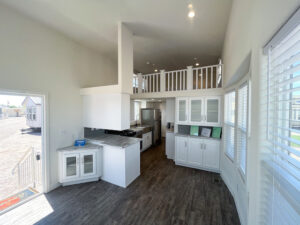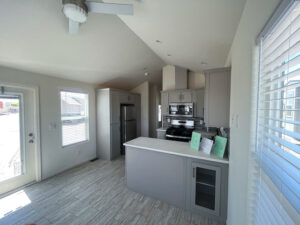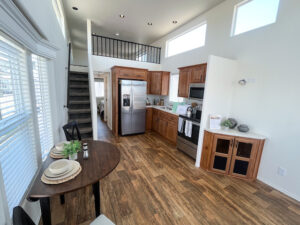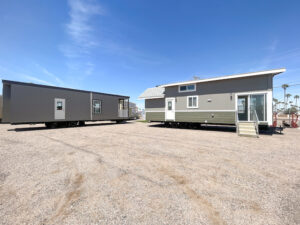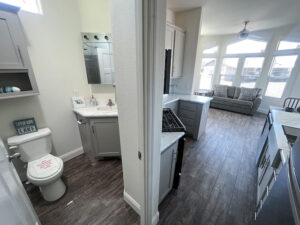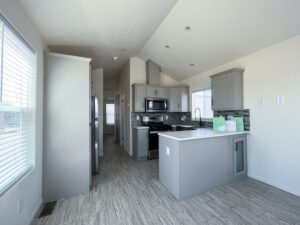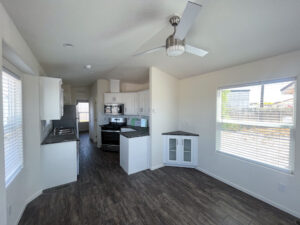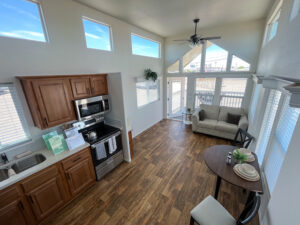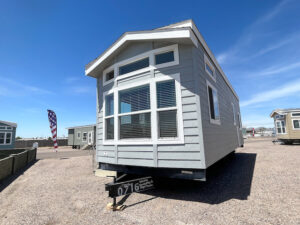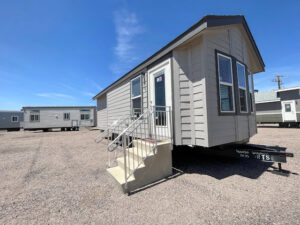(Phoenix, Arizona) — As the United States housing crisis continues, more people seek affordable housing options. Park model homes are a type of home gaining popularity in the market. These homes are typically smaller than traditional houses and built on a chassis, making them easily movable.
In this article, we will explore what park model homes are, the differences between park models and traditional homes, and the advantages and disadvantages of this housing option.
Park model homes are typically between 400 and 500 square feet and built in a factory, often on a chassis with wheels. They are designed to be easily transportable and are usually placed in RV parks, campgrounds, and other communities that allow them.
They are constructed using various materials, including wood, vinyl siding, and fiberglass. They can be built with many of the same materials as traditional homes, but the smaller size and chassis make them more portable.
Unlike traditional homes built on a foundation and permanent lot, park model homes are designed to be moved. Since they are built on a chassis, it allows them to be transported from one location to another.
This is a significant difference between park model homes and traditional homes, which are built on a permanent foundation and cannot be easily moved. Park model homes are also typically smaller than conventional homes, making them a more affordable housing option for those looking to downsize or live in a smaller space.
Park model home and the need for a lot
It’s important to note that if you’re considering purchasing a park model home, you must have or rent a lot to park it. Therefore, the cost of the lot or renting it is an additional expense to consider, along with the cost of the park model home and the cost of transporting it.
Therefore, it’s crucial to research the available lots or communities that allow park-model homes before purchasing. It’s also essential to be aware that, as has been happening, many owners of old mobile homes are being forced out of the lots they have rented for years when the lot owners sell the land to developers.
Since homeowners don’t own the lot, they may be forced to move their homes. Often, their homes are too old to be moved, which can result in significant financial losses. Therefore, it’s crucial to consider these potential risks before purchasing.
Additionally, it’s important to note that many counties in the U.S. don’t allow owners of park model homes to park them in available land in an existing property within conventional home subdivisions or neighborhoods of traditionally built homes. This factor can limit the available options for parking your park model home and may require more research to find a suitable location.
Advantages and disadvantages to consider before purchasing
There are several advantages to owning a park model home. One of the most significant benefits is the cost. They are typically less expensive than traditional homes, making them an affordable housing option for those on a budget.
They are also energy-efficient, which can help reduce energy costs. They are also easier to maintain than traditional homes because they are smaller and require less upkeep. Additionally, because park model homes are built in a factory, they can be constructed more quickly than traditional homes, saving time and money.
However, there are also some disadvantages. One of the most significant disadvantages is the size. While some people may find the smaller size of a park model home an advantage, others may find living in such a small space challenging.
Additionally, park model homes are not always as durable as traditional homes because they are built on a chassis and are designed to be movable. They are also typically not as customizable as conventional homes because they are made in a factory.
Regarding cost, they can be a more affordable housing option than traditional homes. Prices can vary depending on the size, location, and materials used in construction, but park model homes can cost significantly less than traditional homes. According to the RV Industry Association, the average cost of a park model home is between $30,000 and $80,000, whereas the average price of a traditional home is around $380,000.
In terms of size, park model homes are typically smaller than traditional homes, with most being between 400 and 500 square feet. However, some park model homes can be larger, with some models reaching up to 1,000 square feet. The size of a park model home can be an advantage or disadvantage, depending on the individual’s preferences and needs.
Another advantage of park model homes is their energy efficiency. Because they are smaller and designed to be energy-efficient, they can help reduce energy costs. They can also be equipped with solar panels or other alternative energy sources, further reducing energy costs.
In conclusion, park model homes are a new housing option that offers several advantages over traditional homes. They are affordable, energy-efficient, and easier to maintain than conventional homes.
However, they are smaller and less durable than traditional homes and may not be as customizable. Therefore, if you are considering purchasing a park model home, weighing the advantages and disadvantages carefully and determining if it is the right option is essential.
With the ongoing housing crisis and the need for affordable housing options, this may be an attractive alternative for those seeking a smaller, more portable, and energy-efficient home.
© 2023 - 2024, Eduardo Barraza. All rights reserved.



